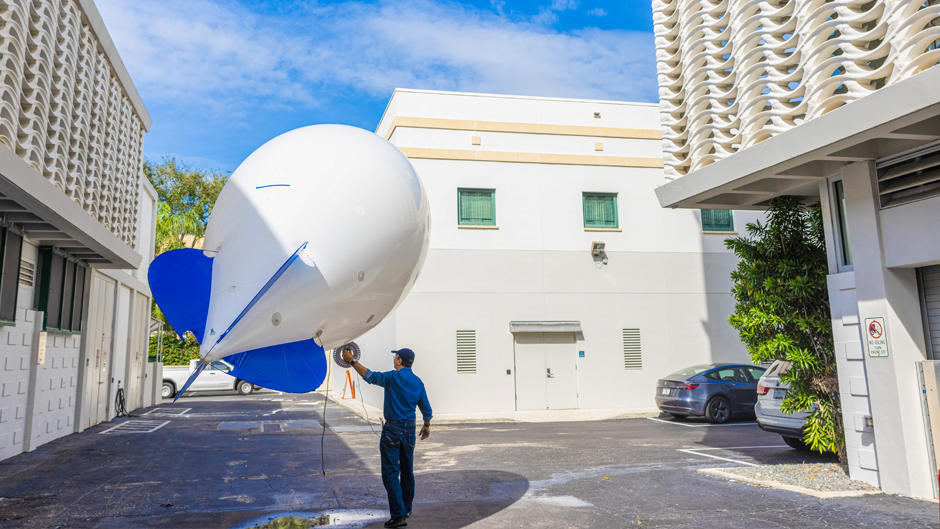Aerosol scientists at the University of Miami College of Engineering took their research to the sky beginning Wednesday in a series of experiments to measure particles over the McArthur Engineering Building. To go beyond conventional ground-level assessments, two aerosol instruments were lifted by Alta Systems’ 12-by-5-foot smart balloon to collect aerosol data at 200 feet of elevation. Because aerosols influence air quality, climate, weather patterns, and other atmospheric processes, the measurement at high altitude will provide new insight into how aerosols impact human health and climate change.
The Center for Aerosol Science and Technology (CAST) is spearheading the experiment, using a particulate matter sensor and aerosol spectrometer attached to the blimp. Assistant professor Yang Wang and doctoral student Shruti Choudhary are leading the effort to obtain a comprehensive vertical profile of airborne particles, including their concentrations, size distributions, and temporal evolution.
Wang emphasized the limitations of surface-level air quality monitoring.
"Most air quality monitoring is conducted at the surface level, but vertical profiling at different altitudes can offer more perspectives regarding the health and climate impacts of the air pollutants,” he said.
Pratim Biswas, dean of the College of Engineering and renowned aerosol researcher, said he is optimistic this experiment will “offer a unique glimpse into aerosols in our own backyard.”
From airborne illnesses to the Sahara Desert dust, Biswas said that “understanding aerosol formation and transformation processes are critical to protecting human health and combatting climate change.”.
Currently, there is a data gap when it comes to the aerosol properties as a function of elevation measured using a suite of aerosol instruments. CAST researchers believe the blimp has great potential to bridge that data gap.
Alta Systems’ blimp uses carbon fiber to reduce the system’s weight while enhancing its mechanical stability. The blimp is tethered by an ultra-lightweight string that can transmit power and data during the flight. Their mobile command center is also equipped with state-of-the-art technology that allows real-time recording and broadcasting of aerial images and data for immediate analysis by researchers.
“Alta technology has been used extensively to monitor human activity from the air,” said Chris Ciampa, chief operating officer at Alta Systems. “Now, we are thrilled to have the opportunity to work with CAST at the University of Miami to conduct groundbreaking research that will improve the quality of human life and environments.”
While researchers will have access to data immediately, the upcoming days will be dedicated to consolidating information from various instruments. The experiment is taking place during CAST’s second annual Summer School in Winter Workshop that draws aerosol researchers from across the United States.

